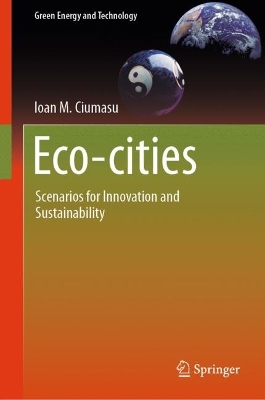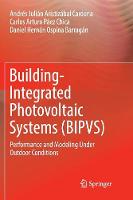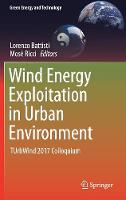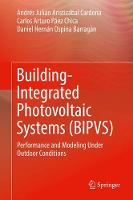Sustainable Building for a Cleaner Environment
 -15%
portes grátis
-15%
portes grátis
Sustainable Building for a Cleaner Environment
Selected Papers from the World Renewable Energy Network's Med Green Forum 2017
Sayigh, Ali
Springer International Publishing AG
07/2018
471
Dura
Inglês
9783319945941
15 a 20 dias
887
Descrição não disponível.
Chapter 1. Proposing a new method for fenestration shading design in prefabricated modular buildings.- Chapter 2.Effectiveness of occupant behavioral ventilation strategies on indoor thermal comfort in hot-arid climate.- Chapter 3.Effectiveness of materials, technologies and renewable energy in educational buildings through cluster analysis of energy retrofitting.- Chapter 4.Renewable Energy in Argentina.- Chapter 5.Wind energy potential research in a low building within an urban environment.- Chapter 6.The natural light in Architecture. The use inspired by the constructive tradition.- Chapter 7.The cost of building to the near Zero Energy Building standard - a financial case study.- Chapter 8.Policy of intensification, diversification, conservation, and indexation in pursuing the sustainable transport.- Chapter 9.Problem of education in developing renewable of energy.- Chapter 10.Winter performance of certified passive houses In a Temperate Maritime Climate - nZEB Compliant?.- Chapter11.A parametric tool for assessing optimal location of buildings according to environmental Criteria.- Chapter 12.Methodology of Solar Project Managing Through All Stages of Development.- Chapter 13.Computational BIPV Design: An energy optimization tool for solar facades.- Chapter 14.Feasibility Study of a Low Carbon House in the UK.- Chapter 15.Why Do We Need To Reduce The Carbon Footprint In UAE?.- Chapter 16.Urban farming in the era of crisis in greece: the case study of the urban garden of Agioi Anargiroi -Kamatero and Fili.- Chapter 17.Resilient urban design- Beograd and Florence: Reconnect the waters to the city.- Chapter 18.Strategic Sustainable and Smart Development Based on User Behavior.- chapter 19.High Bombastic adaptive skin conceptual prototype for mediterranean climate.- Chapter 20. Quality of healthcare: a review of the impact of hospital physical environment on improving quality of care.- Chapter 21. Enhancing Indoor Air Quality for Residential Building in Hot Arid Regions.- Chapter 22.Performance of Solar Window Film With Reference to Energy Rationalizing in Buildings.- Chapter 23.Visualizing the infrared response of an urban canyon throughout a sunny day.- chapter 24.Meta-design approach to Environmental building programming for passive cooling of Buildings.- Chapter 25.Urban and Architectural Sustainability in Restoration of Iranian cities (Strategy and Challenges), Case study of Soltaniyeh.- Chapter 26.-Influence of the pariod of measurements on wind potential assessment for a given site.- Chapter 27.Integration strategies of Luminescent Solar Concentrators panels: a case study in Florence - Italy.- Chapter 28.Photovoltaic and Thermal solar concentrator integrated into a dynamic shading device.- Chapter 29.A University Master Course and training program for energy managers and expert in environmental design in Italy.- Chapter 30.A project for the NZERO-Foundation in the south of Italy.- Chapter 31.Planning without waste.- Chapter 32. Problem OfEducation In Developing Renewable Of Energy.- Chapter 33.Problem Of Education In Developing Renewable Of Energy.- Chapter 34. Resilient urban design. beograd and florence: reconnect the waters to the city.- Chapter 35.Evaluating deep retrofit strategies for buildings in urban waterfronts.- Chapter 36.Enhancing the Thermo-physical Properties of Rammed Earth by Stabilizing with Corn Husk Ash.- Chapter 37.Thermal monitoring of low income housings built with autoclaved aerated concrete in a hot-dry climate.- Chapter 38.Renewables are commercially justified to save fuel and not for storage.- Chapter 39.Climate Change Assessment, Simulation and Adaptation for Hot-Arid Urban Settlements: The Case Study of Asmara Project, Cairo, Egypt.- Chapter 40.Climate Change Assessment, Simulation and Adaptation for Hot-Arid Urban Settlements: The Case Study of Asmara Project, Cairo, Egypt.- Chapter 41.Ventilation effectiveness of residential ventilation systems and its energy saving potential.- Chapter 42.Assessment of cardboard as an environment-friendly wall thermal insulation for low energy prefabricated buildings.
Este título pertence ao(s) assunto(s) indicados(s). Para ver outros títulos clique no assunto desejado.
Sustainable architecture;Renewable energy;Electricity production;Transportation;Climate adaptive design;Green infrastructure;Maritime climates;Smart design;Eco-tourism;Smart islands
Chapter 1. Proposing a new method for fenestration shading design in prefabricated modular buildings.- Chapter 2.Effectiveness of occupant behavioral ventilation strategies on indoor thermal comfort in hot-arid climate.- Chapter 3.Effectiveness of materials, technologies and renewable energy in educational buildings through cluster analysis of energy retrofitting.- Chapter 4.Renewable Energy in Argentina.- Chapter 5.Wind energy potential research in a low building within an urban environment.- Chapter 6.The natural light in Architecture. The use inspired by the constructive tradition.- Chapter 7.The cost of building to the near Zero Energy Building standard - a financial case study.- Chapter 8.Policy of intensification, diversification, conservation, and indexation in pursuing the sustainable transport.- Chapter 9.Problem of education in developing renewable of energy.- Chapter 10.Winter performance of certified passive houses In a Temperate Maritime Climate - nZEB Compliant?.- Chapter11.A parametric tool for assessing optimal location of buildings according to environmental Criteria.- Chapter 12.Methodology of Solar Project Managing Through All Stages of Development.- Chapter 13.Computational BIPV Design: An energy optimization tool for solar facades.- Chapter 14.Feasibility Study of a Low Carbon House in the UK.- Chapter 15.Why Do We Need To Reduce The Carbon Footprint In UAE?.- Chapter 16.Urban farming in the era of crisis in greece: the case study of the urban garden of Agioi Anargiroi -Kamatero and Fili.- Chapter 17.Resilient urban design- Beograd and Florence: Reconnect the waters to the city.- Chapter 18.Strategic Sustainable and Smart Development Based on User Behavior.- chapter 19.High Bombastic adaptive skin conceptual prototype for mediterranean climate.- Chapter 20. Quality of healthcare: a review of the impact of hospital physical environment on improving quality of care.- Chapter 21. Enhancing Indoor Air Quality for Residential Building in Hot Arid Regions.- Chapter 22.Performance of Solar Window Film With Reference to Energy Rationalizing in Buildings.- Chapter 23.Visualizing the infrared response of an urban canyon throughout a sunny day.- chapter 24.Meta-design approach to Environmental building programming for passive cooling of Buildings.- Chapter 25.Urban and Architectural Sustainability in Restoration of Iranian cities (Strategy and Challenges), Case study of Soltaniyeh.- Chapter 26.-Influence of the pariod of measurements on wind potential assessment for a given site.- Chapter 27.Integration strategies of Luminescent Solar Concentrators panels: a case study in Florence - Italy.- Chapter 28.Photovoltaic and Thermal solar concentrator integrated into a dynamic shading device.- Chapter 29.A University Master Course and training program for energy managers and expert in environmental design in Italy.- Chapter 30.A project for the NZERO-Foundation in the south of Italy.- Chapter 31.Planning without waste.- Chapter 32. Problem OfEducation In Developing Renewable Of Energy.- Chapter 33.Problem Of Education In Developing Renewable Of Energy.- Chapter 34. Resilient urban design. beograd and florence: reconnect the waters to the city.- Chapter 35.Evaluating deep retrofit strategies for buildings in urban waterfronts.- Chapter 36.Enhancing the Thermo-physical Properties of Rammed Earth by Stabilizing with Corn Husk Ash.- Chapter 37.Thermal monitoring of low income housings built with autoclaved aerated concrete in a hot-dry climate.- Chapter 38.Renewables are commercially justified to save fuel and not for storage.- Chapter 39.Climate Change Assessment, Simulation and Adaptation for Hot-Arid Urban Settlements: The Case Study of Asmara Project, Cairo, Egypt.- Chapter 40.Climate Change Assessment, Simulation and Adaptation for Hot-Arid Urban Settlements: The Case Study of Asmara Project, Cairo, Egypt.- Chapter 41.Ventilation effectiveness of residential ventilation systems and its energy saving potential.- Chapter 42.Assessment of cardboard as an environment-friendly wall thermal insulation for low energy prefabricated buildings.
Este título pertence ao(s) assunto(s) indicados(s). Para ver outros títulos clique no assunto desejado.






